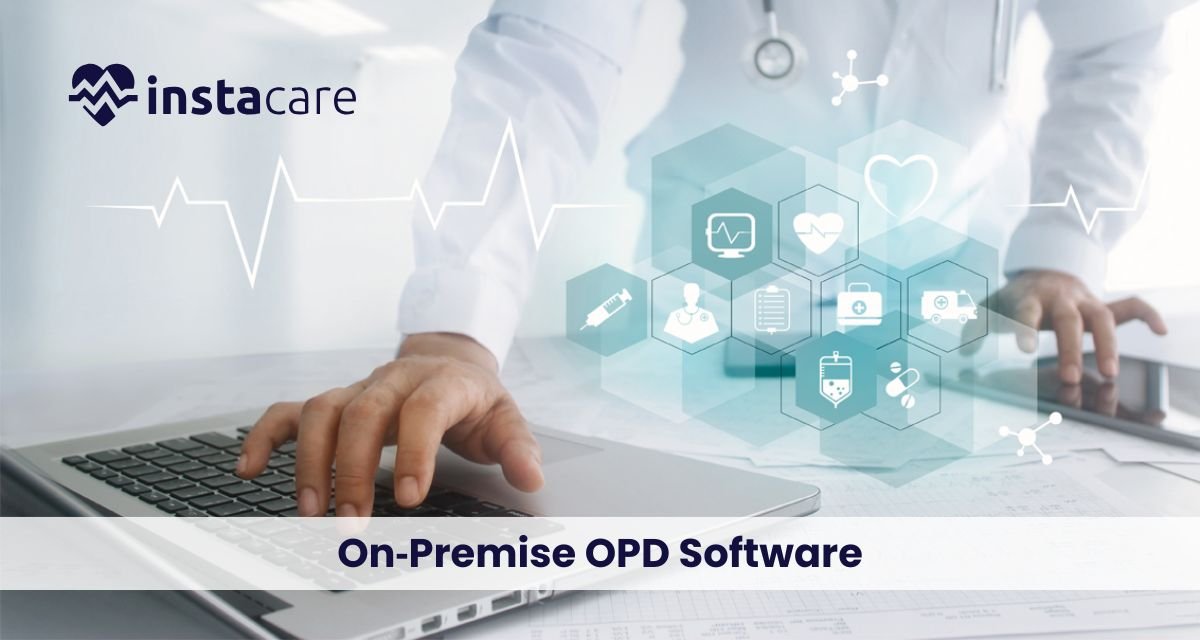Last updated on Tuesday, 4, November, 2025
Table of Contents
Why Clinics Choose On-Premise OPD Software: Benefits, Challenges & Best Practices?
In contemporary medical institutions, technology has become an important part of running a clinic, whereby it helps in the management of patients, records, and appointments. Clinics especially require effective systems that will facilitate the operations of their outpatients. Here, an OPD management system is required.
On-premise solutions are preferable to many healthcare providers due to the fact that they provide greater control, privacy of data, and customisation. The reason as to why clinics opt for on-premise OPD software is useful in making informed decisions in the quest to ensure improved operational efficiency and patient satisfaction.
What is On-Premise OPD Software?
On-premise hospital software is deployed and runs straight off the local servers of the clinic as opposed to being run in the cloud. This provides the healthcare administrators with full control of their system infrastructure and data security.
The outpatient department software assists the medical professionals to handle the registration of patients, appointments, consultations, billing, and reports within the premises. It is not reliant on any external servers on the internet as compared to a cloud based system and therefore it is best suited to clinics that place control and data security at a low level.
Key Features for OPD Management (on-premise)
In the case of selecting an on-premise solution, it is important to be aware of the OPD software features. An effective system must offer:
- Full registration of patients by an inbuilt OPD registration system that reduces manual and error entries.
- Workflow management tools that have automated the daily Hospital OPD workflow management such as patient check in and discharge.
- OPD appointment scheduling software enables clinics to organize and control the availability of the doctors, minimize the waiting time, and enhance patient experience.
- EMR integration in OPD software to allow easy access to the electronic medical record to facilitate a more accurate diagnosis and treatment.
- Customer support capabilities of Patient record management system to have structured, secured and easily accessible data.
- Intensive OPD billing software to ease the payment processing, insurance claims and invoicing.
- OPD queue management system that enhances the flow of patients and minimizes congestion in waiting rooms.
Benefits of On-Premise OPD Software
Benefits of on-premise OPD software that clinics would be tempted to go to this model:
- Data Security and Control: Clinics are fully in control of their databases and so their secure OPD data management without having to use external servers.
- Personalization: On-premise systems are customizable to suit the clinic in terms of its needs, workflow and departmental organization.
- Offline Capability: It is not reliant on an internet connection and therefore, functions will not be affected by the failure of a network.
- Better Response Time: The speed of data retrieval and internal communication is faster since the system is running in the local network.
- Regulatory Compliance: The clinics are able to accomplish regulatory safety on healthcare data protection by managing the access permissions within the internal system.
Challenges & Considerations of On-Premise OPD Software
The benefits are impressive, but there are other issues to address prior to deploying an on-premise solution:
- Initial Investment: Once server and infrastructure are set up to run an on-premise OPD system, the initial cost is higher in opposition to cloud systems.
- Maintaining and Updates: The IT department of the clinic should handle software updates, backups, and technical support which may serve as an addition to operational tasks.
- Scalability Problems: There may need to be more hardware investment in order to scale system capacity.
- Data Backup Risks: In case it is not configured correctly, local data might be lost in technical malfunctions or physical damages.
These limitations should be considered by the clinics against their long-term objectives and resources before they opt to adopt on-premise models. This analogy results in the comparison of on-premise vs cloud OPD software in a bid to establish the most suitable.
Book Your Free Marketing Consultation
Implementation of Best Practices On-Premise OPD Software
A proper planning and execution are necessary in order to implement on-premise systems. Here are a few best practices:
- Needs Assessment: Decipher what the clinic needs: both in terms of functionality and technicality.
- Vendor Selection: Select a provider with good reputation in OPD software for clinics and with after sales services.
- Infrastructure Preparedness: The clinic should have a well-built hardware, power backup system, and safe data storage systems.
- Staff Training: Educate the doctors, nurses and administrative personnel with the features of the software in order to adapt to it.
- Periodic Maintenance: Have routine audits of the system, security check ups, and updates to ensure that the system is functioning at optimal levels.
- Data Security Procedures: Have stringent access control and backup procedures to ensure safe storage of information.
The practices assist the clinics in maximizing the efficiency of software with a minimum of technical disruptions.
When On-Premise Makes Sense?
The on-premise system is advantageous, especially under certain situations. Clinics with high confidentiality over patient information, internal IT department, or work in areas with poor internet connectivity are the most beneficial. It is also perfect where there is a need for customization of facilities or integration with older systems.
As an illustration, small-to-medium hospitals and diagnostic facilities that put more emphasis on in-house data control find on-premise deployment to be the most suitable option to their operations.
How to Choose the Right On-Premise OPD Software?
When deciding on the appropriate on-premise system, various factors should be considered:
- Compatibility: Let the software be compatible with these other tools and hospital systems.
- User-friendliness: Select a solution with a user-friendly interface at every level of staff.
- Support and Training: Go to vendors that provide on-going technical support and training opportunities.
- Scalability: Select software with the ability to scale to your clinic as it grows and as your patient volume increases.
- Security Standards: Make sure that it complies with healthcare data protection legislation and encryption policies.
A careful consideration of these factors will make the clinic invest in a long-term and efficient digital healthcare management solution.
Conclusion
On-premise OPD software still remains popular among several health care providers because of its control, security and customization. It follows with some set up and maintenance setbacks, but it has no competition in the long term stability of its operational performance.
To the clinics that value the privacy of patient data, efficiency, and autonomy of the system, an on-premise OPD solution can make a considerable difference in the quality of the provided services and the consistency of the workflow.
FAQs
1. What is the difference between on-premise and cloud OPD software?
On-premise software is installed on the servers of the clinic in the local environment, whereas the cloud software is offered on the servers on the internet. On-premise systems have more data control whereas cloud systems have more flexibility.
2. Is it possible to have on-premise OPD software, which can be integrated with EMR systems?
Yes, the present-day on-premise OPD systems can be fully integrated with EMRs, and clinics can have continuous access to electronic medical records.
3. Does on-premise OPD software make sense to small clinics?
The cost of the first set up is quite high, but the long-run results, such as data control, customization and low subscription charges can be used by small clinics to save.



